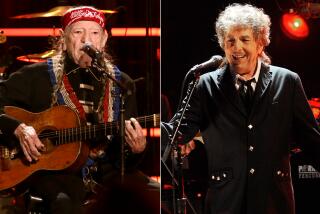Review: Dave Rawlings Machine and John Paul Jones stay true to roots
- Share via
Dave Rawlings waited until the final moments of his concert Monday night to introduce his mandolin player — which wouldn’t have seemed surprising if the guy in question hadn’t been a world-famous rock star.
That’s a reasonable way to describe John Paul Jones, even if the Led Zeppelin bassist looked more like a humble sideman onstage at Immanuel Presbyterian Church. The cathedral on Wilshire Boulevard is where Rawlings, a well-connected roots-music figure best known for his work with the singer Gillian Welch, ended a West Coast tour with the group he calls the Dave Rawlings Machine.
Jones wasn’t its only high-profile member, either. On Monday, the outfit’s shifting lineup included Welch on guitar, Paul Kowert of Punch Brothers on upright bass and, on guitar and banjo, Willie Watson, who helped found Old Crow Medicine Show (and whose recent solo debut was produced by Rawlings). Each looms large in the sprawling Americana scene that’s flourished in the decade and a half since “O Brother, Where Art Thou?” repopularized music by Skip James and the Carter Family.
Yet nothing about this cheerful, occasionally rowdy gig suggested that these heavyweights had come to make themselves feel important; their focus seemed firmly on keeping an old-timey string-band style alive.
In part that meant revving up standards such as “Will the Circle Be Unbroken?” and “This Land Is Your Land,” which the musicians sang in tightly braided vocal harmony that led Rawlings to tell the audience, “This is starting to sound like a folk concert.” Later the musicians joined voices again for a warmly affectionate rendition of “The Weight,” the late-’60s Band song that already feels twice its age.
But Rawlings and his mates also played material of their own, and it was that music — with its vivid juxtaposition of antique noise and modern imagery — that most honored tradition by demonstrating how useful it can be.
In “Sweet Tooth,” one of several tunes the group did from the Dave Rawlings Machine’s 2009 album “A Friend of a Friend,” he and Welch sang about addiction with a clarity of tone in beguiling contrast with the song’s cutesy candy metaphor. They were equally piercing in the tender “Bells of Harlem,” about a troubled person experiencing “a little joy at long last.”
And Welch flashed her sly sense of humor in “Look at Miss Ohio,” a finely detailed portrait of small-town life that Miranda Lambert brought to a wider audience a few years ago when the country star recorded it for her album “Four the Record.”
The emphasis on songs didn’t mean the players restrained their technical abilities.
In “Dry Bones,” Watson’s fingers were a blur on the neck of his banjo, a happy fulfillment of Rawlings’ stated plan to ensure the crowd was “getting enough banjo in [its] diet.” Even more frenetic were the licks that Rawlings and Jones traded on guitar and mandolin, respectively, during a long rendition of Neil Young’s “Cortez the Killer.”
But the shredding felt secondary to the vibe.
At the end of the show, not long after Rawlings had finally singled out his pal from the Rock and Roll Hall of Fame, the five members of the Machine lowered their instruments and gathered around a single microphone for a stirring a cappella take on the traditional “Didn’t Leave Nobody but the Baby.”
They didn’t need anything else.
Twitter: @mikaelwood
More to Read
The biggest entertainment stories
Get our big stories about Hollywood, film, television, music, arts, culture and more right in your inbox as soon as they publish.
You may occasionally receive promotional content from the Los Angeles Times.











